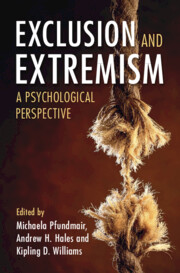Book contents
- Exclusion and Extremism
- Exclusion and Extremism
- Copyright page
- Dedication
- Contents
- Contributors
- Introduction
- Part I The Link between Exclusion and Extremism
- 1 Ostracism and Extremism
- 2 Exclusion and Radicalization
- 3 In the Realm of Action
- 4 Seeking the Self in the Extreme
- 5 Buying the Blackpill
- Part II Drivers of the Exclusion–Extremism Link
- Part III Topics Related to the Exclusion–Extremism Link
- Index
- References
1 - Ostracism and Extremism
How Extreme Groups Can Address Threatened Needs
from Part I - The Link between Exclusion and Extremism
Published online by Cambridge University Press: 16 May 2024
- Exclusion and Extremism
- Exclusion and Extremism
- Copyright page
- Dedication
- Contents
- Contributors
- Introduction
- Part I The Link between Exclusion and Extremism
- 1 Ostracism and Extremism
- 2 Exclusion and Radicalization
- 3 In the Realm of Action
- 4 Seeking the Self in the Extreme
- 5 Buying the Blackpill
- Part II Drivers of the Exclusion–Extremism Link
- Part III Topics Related to the Exclusion–Extremism Link
- Index
- References
Summary
Can the experience of being ostracized – ignored and excluded – lead to people being more open to extremism? In this chapter we review the theoretical basis and experimental evidence for such a connection. According to the temporal need-threat model (Williams, 2009), ostracism is a painful experience that threatens fundamental social needs. Extreme groups have the potential to be powerful sources of inclusion and could therefore address these needs, thereby making them especially attractive to recent targets of ostracism. We also identify a set of factors that is theoretically likely to affect this link and review evidence for the opposite causal path: People are especially likely to ostracize others who belong to extreme groups. Together, this suggests a possible negative cycle in which ostracism may push people toward extreme groups, on which they become more reliant as social contacts outside the group further ostracize them.
- Type
- Chapter
- Information
- Exclusion and ExtremismA Psychological Perspective, pp. 7 - 26Publisher: Cambridge University PressPrint publication year: 2024

